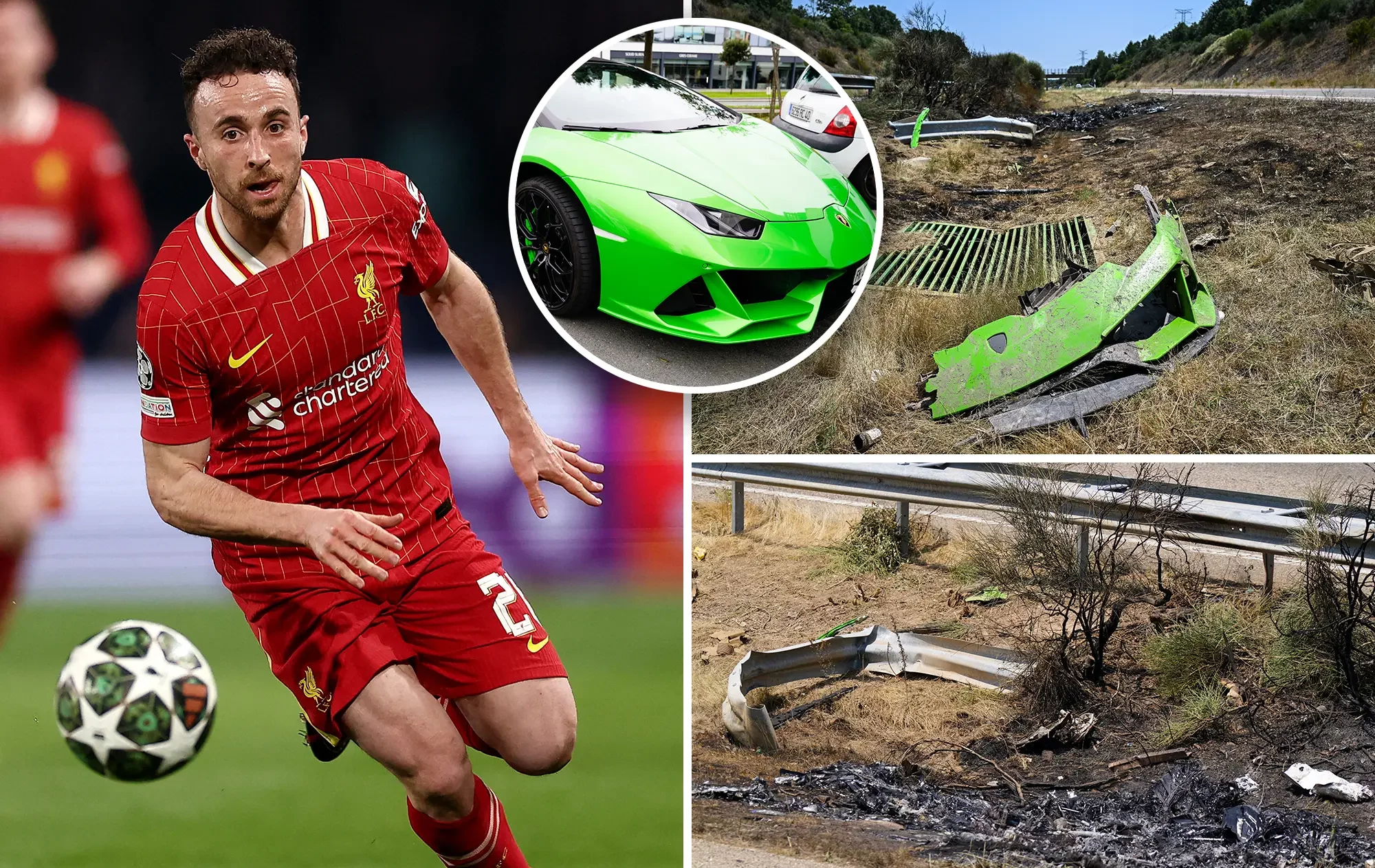On the morning of July 3, 2025, the football world was rocked by the devastating news of the deaths of Liverpool FC star Diogo Jota and his brother, André Silva, in a horrific car crash on Spain’s A-52 highway near Zamora. The accident, which claimed the lives of the two brothers just 11 days after Jota’s wedding, sent shockwaves through the global sports community. Recent developments have brought new clarity to the tragedy, as authorities have successfully recovered and analyzed the vehicle’s black box, shedding light on the precise factors that led to the catastrophic collision. This article delves into the details of the black box findings, offers a critical analysis of the contributing factors, and reflects on the broader implications for road safety and automotive design.
The Accident: A Heartbreaking Loss
Diogo Jota, a 28-year-old Portuguese forward who played a pivotal role in Liverpool’s Premier League success, and his 26-year-old brother André Silva, a professional footballer for FC Penafiel, were traveling from Porto to Santander to catch a ferry to the UK. Jota, recently recovered from lung surgery, had been advised by doctors to avoid air travel due to the risk of exacerbating his condition. This medical advice led the brothers to embark on a 10-hour road journey in a Lamborghini, a decision that would tragically end in disaster.
The crash occurred at approximately 12:30 a.m. on the A-52 highway, a notorious accident blackspot in northwestern Spain. According to initial reports from Spain’s Guardia Civil, the Lamborghini veered off the road, rolled, and burst into flames following a tire blowout while overtaking another vehicle. The intensity of the fire made it challenging to identify the occupants initially, but the vehicle’s license plate confirmed the identities of Jota and Silva. The football community, including teammates, coaches, and fans, mourned the loss of two talented athletes and beloved figures, with tributes pouring in from across the globe.
Black Box Recovery: A Breakthrough in the Investigation
In the days following the crash, Spanish authorities, in collaboration with automotive experts, located and recovered the vehicle’s black box, a device akin to those used in aviation, designed to record critical data about a car’s performance and driver inputs. The successful retrieval of the black box, despite the extensive damage caused by the fire, marked a significant breakthrough in the investigation. The data extracted from the device has provided a detailed timeline of the events leading up to the collision, offering insights into the mechanical and human factors at play.
![]()
The black box data confirmed that the Lamborghini, believed to be a Huracan model, was traveling at a high speed—potentially exceeding 120 mph—when the tire blowout occurred. The sudden loss of tire pressure caused the vehicle to become unstable, particularly during an overtaking maneuver, which required precise handling. The data also revealed that the car’s advanced stability control systems attempted to compensate for the loss of traction but were overwhelmed by the combination of speed, road conditions, and the abrupt mechanical failure. Within seconds, the vehicle veered off the highway, struck a roadside barrier, and rolled multiple times before igniting.
Analyzing the Causes: A Multifaceted Tragedy
The black box findings point to a complex interplay of factors that contributed to the accident, each of which warrants careful scrutiny.
1. Tire Blowout: A Mechanical Failure with Devastating Consequences
The primary trigger of the crash was the tire blowout, which multiple sources, including the Guardia Civil and BBC Sport, have identified as the initiating event. The black box data indicates that the blowout occurred in the front left tire, likely due to a combination of high speed, heat buildup, and possible tire wear. Lamborghini Huracan models are equipped with high-performance tires designed for extreme conditions, but these tires are also highly sensitive to factors such as overinflation, underinflation, or prolonged high-speed driving.
Critically, the recovered data suggests that the tire may have been operating at suboptimal pressure, a condition that could have gone unnoticed during routine maintenance. Furthermore, reports indicate that the Huracan model involved in the crash was subject to multiple recalls over the years, including issues related to tire compatibility and suspension components. While it remains unclear whether the specific vehicle had unresolved recall issues, this raises questions about the reliability of high-performance supercars under real-world conditions.
2. High Speed and Overtaking: A Risky Maneuver
The black box data underscores the role of excessive speed in the accident. Traveling at over 120 mph, the Lamborghini was operating well beyond the legal speed limit of the A-52 highway, which is typically 75 mph. The decision to overtake another vehicle at such a high speed amplified the risks, as even a minor disruption—such as a tire blowout—could lead to catastrophic loss of control.
Spanish authorities have noted that the A-52 is a known accident blackspot, with a history of collisions attributed to its winding layout and variable road conditions. The black box data indicates that the road surface was dry at the time of the crash, ruling out weather as a factor. However, the high-speed overtaking maneuver may have placed undue stress on the vehicle’s tires and suspension, exacerbating the impact of the blowout.
3. Human Factors: Fatigue and Decision-Making
Another critical aspect revealed by the black box is the timing of the crash—12:30 a.m. after a long journey from Porto. The brothers had been driving for several hours, raising the possibility of driver fatigue. While the black box cannot directly measure fatigue, the late hour and extended travel time suggest that Jota, who was likely behind the wheel, may have been operating under less-than-optimal conditions. Fatigue can impair reaction times and decision-making, potentially delaying the response to the tire blowout.
Moreover, the decision to drive rather than fly was influenced by medical advice, but it also reflects a broader issue of risk assessment. The choice to undertake a 10-hour drive in a high-performance vehicle, particularly at night, introduced variables that may not have been fully considered. This underscores the need for better guidance from medical professionals and support systems for athletes navigating recovery and travel.
4. Vehicle Design and Safety Systems
The Lamborghini Huracan is renowned for its performance but is not designed with the same safety margins as more conventional vehicles. The black box data indicates that the car’s electronic stability control and anti-lock braking systems engaged during the incident but were unable to prevent the loss of control. This highlights a limitation of supercars, which prioritize speed and agility over robustness in extreme failure scenarios.

Additionally, the rapid spread of the fire following the crash points to potential vulnerabilities in the vehicle’s fuel system or materials. The black box recorded a near-instantaneous ignition after the rollover, suggesting that a fuel line rupture or battery short-circuit may have contributed to the blaze. This aspect of the accident warrants further investigation, particularly in light of Lamborghini’s recall history for the Huracan model.
Broader Implications: Lessons for Road Safety and Automotive Design
The recovery of the black box and the insights it provides offer valuable lessons for improving road safety and automotive engineering. First, the incident highlights the importance of regular tire maintenance, particularly for high-performance vehicles. Manufacturers and dealerships should prioritize educating owners about the unique demands of supercar tires, including proper inflation, wear monitoring, and replacement schedules.
Second, the tragedy underscores the dangers of high-speed driving on public roads, especially in areas with known hazards. Authorities in Spain and beyond should consider enhanced signage, speed enforcement, and infrastructure improvements for accident-prone highways like the A-52. Public awareness campaigns targeting young, affluent drivers—who are often drawn to supercars—could also mitigate risks.
Third, the automotive industry must address the safety trade-offs inherent in high-performance vehicles. While supercars like the Lamborghini Huracan are engineering marvels, their design prioritizes performance over crash survivability. Manufacturers should invest in advanced fire-suppression systems, reinforced fuel lines, and more robust stability controls to better handle catastrophic failures like tire blowouts.

Finally, the role of medical advice in shaping travel decisions cannot be overlooked. Jota’s decision to drive was rooted in a desire to protect his health, yet it inadvertently exposed him to greater risks. Healthcare providers should collaborate with patients to assess all available options, including alternative modes of transportation or recovery timelines that avoid such dilemmas.
Conclusion: A Tragedy That Demands Action
The successful recovery of the black box from Diogo Jota’s Lamborghini has provided critical insights into the causes of the tragic crash that claimed the lives of two promising footballers. The data reveals a perfect storm of mechanical failure, high speed, human factors, and vehicle limitations, compounded by the inherent risks of a dangerous roadway. While the findings cannot undo the heartbreak felt by Jota’s family, teammates, and fans, they offer a roadmap for preventing similar tragedies in the future.
As the football world continues to mourn, the legacy of Diogo Jota and André Silva can inspire meaningful change. By addressing the systemic issues exposed by this accident—tire safety, road design, vehicle engineering, and travel decision-making—society can honor their memory and ensure that such a loss is never repeated. The black box has spoken; now, it is up to us to listen and act.




